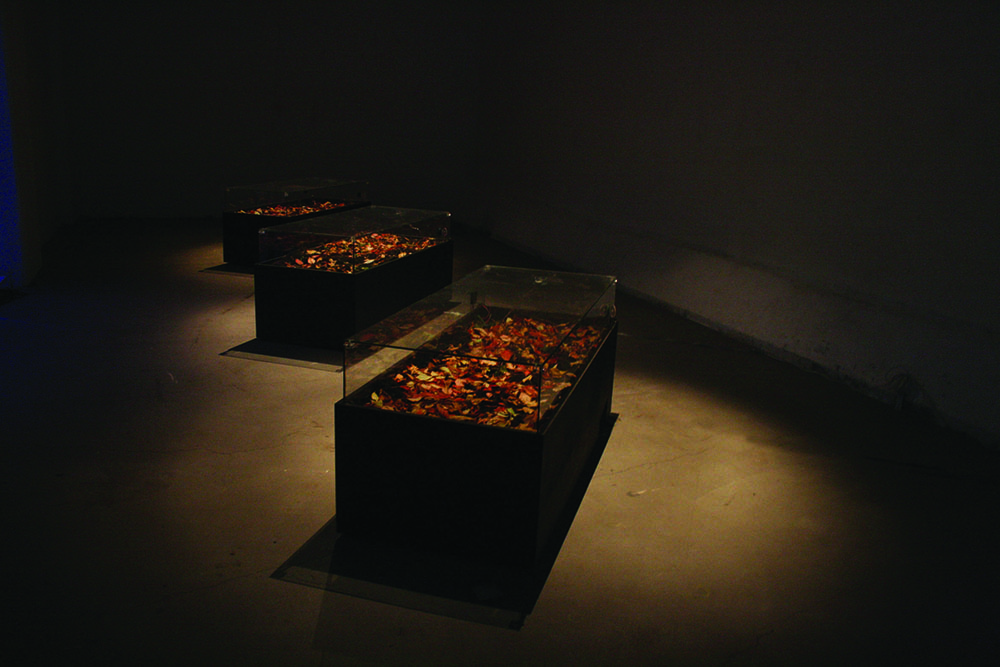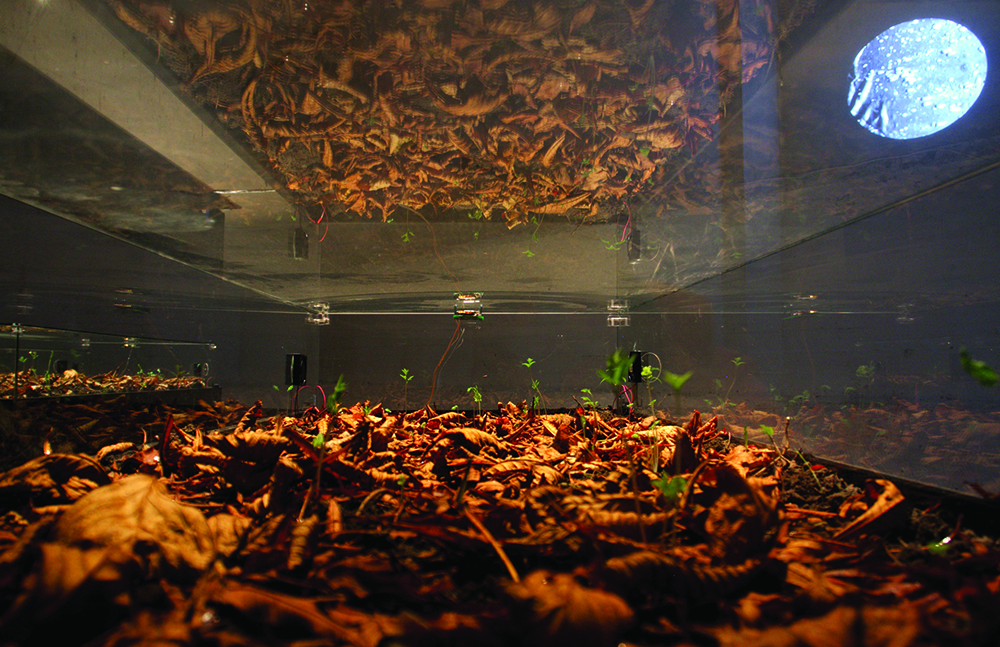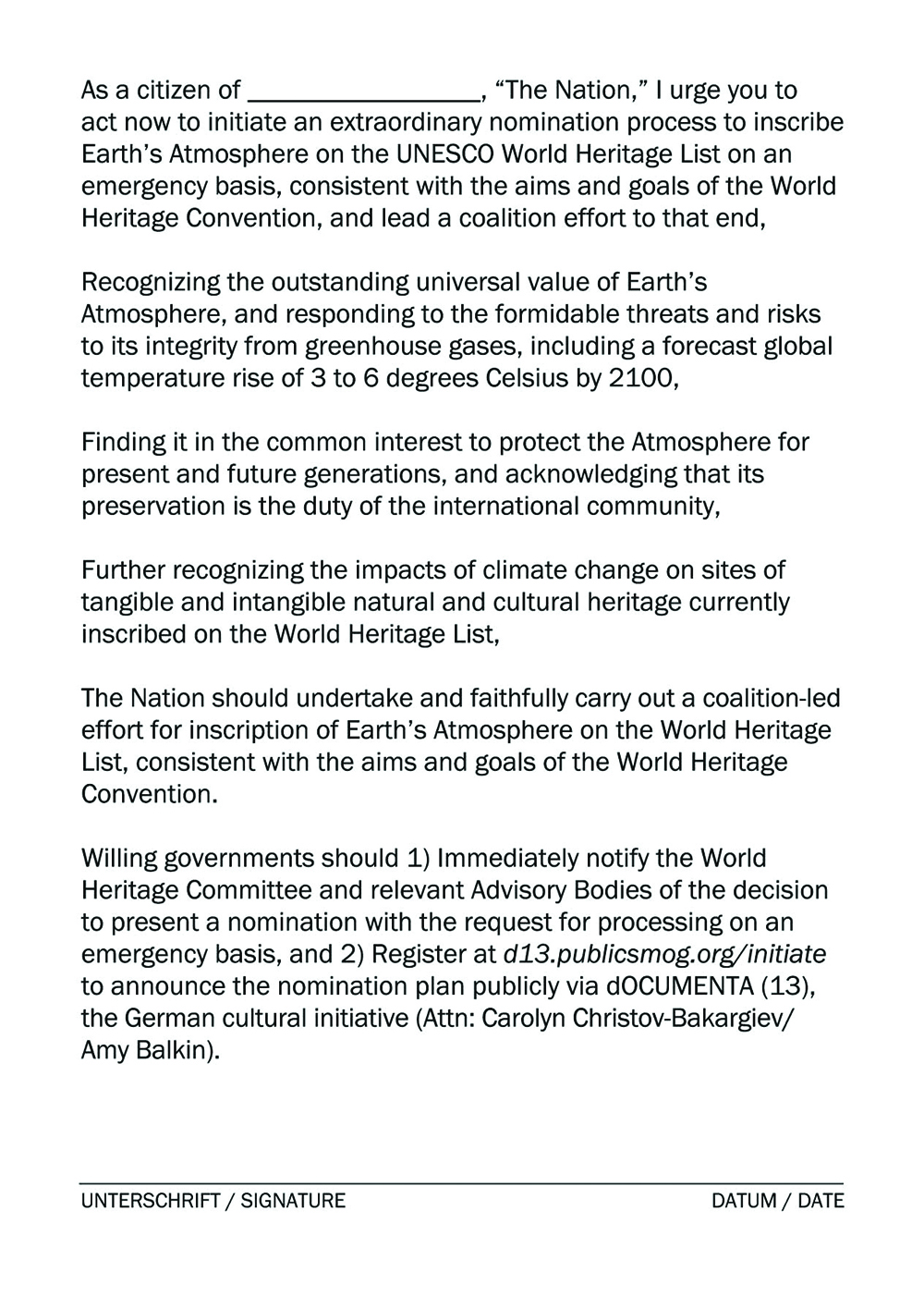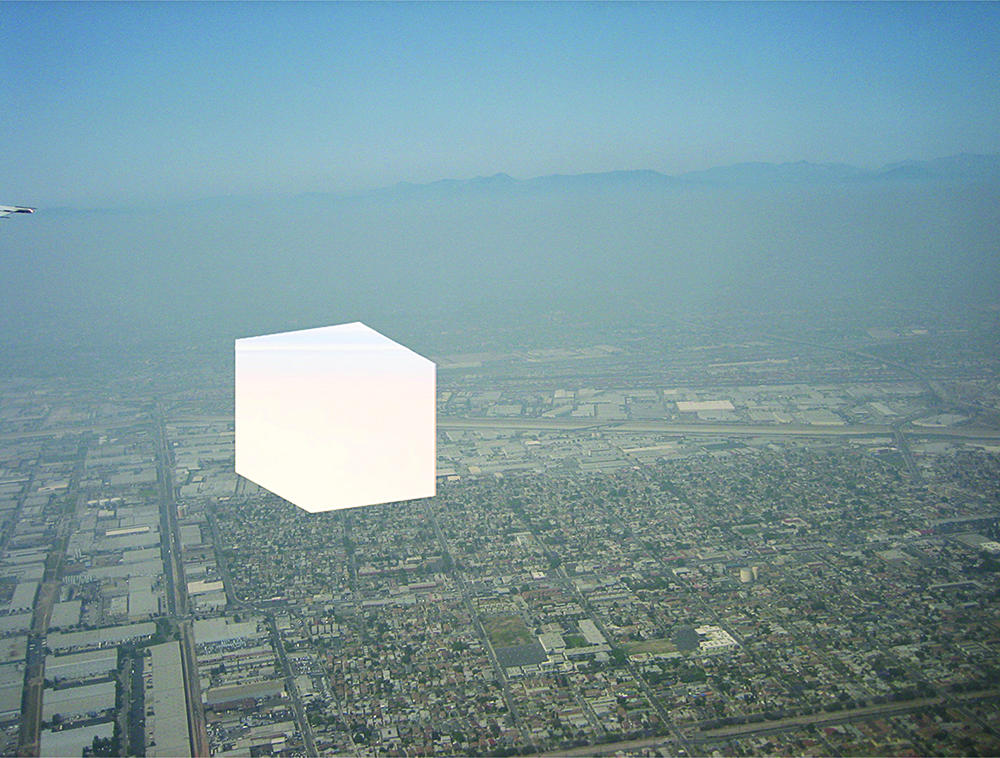The following essay will appear in Climates: Architecture and the Planetary Imaginary, published this spring by the Avery Review and Lars Müller Publishers.

The human-size rectangular glass box emits a slow whoosh. A pause. And then again. It sighs. Inside the box are leaves—leaves slowly decomposing. And as they decompose, they exhale. A sound made audible to our ears through the use of carbon dioxide sensors, adapted from forestry management. Ventilation fans on either side of the box open and close, like gills. This is the breath of the earth as it is transforming. Moving through the processes of decay to nourish the soil. As the leaves exhale the carbon they have been storing throughout their lives, it releases into the atmosphere. Molecular structures exchange and transform. As they breathe out, exhale, the leaves become molecular.

This 2008 work, Inhale–Exhale, by Finnish artist Terike Haapoja, which was exhibited in the installation “Closed Circuit–Open Duration” at the Nordic Pavilion of the Venice Biennale of Art in 2013, affectively attunes us to the carbon cycle. The numeracy of the climate crisis, the endless barrage of statistics, here gives way to breath—to the sound of breath, to the sound of the breath of the leaves, of the soil. To the exhale we then inhale. Climate statistics pulled inside our lungs. Levels of carbon dioxide and methane and oxygen registered as vibration. “It is not enough,” Haapoja says, “to show the workings of carbon in the ecosystem: we need to try to see what does CO2 mean to us, how does it work its way in our own inner reality, the reality of love, and bodily being, and death.”1 The story of the carbon cycle is the story of things passing in and out of being, of transformation, of composition and decomposition. Haapoja proposes that these cycles are intimate, pulled into our most constitutive and basic elements of being. I would like to take up this proposition. How, in the midst of contemporary political debates about carbon, carbon dioxide, and carbon economies, might a shift in discourse toward affective attunement—toward an intimate engagement with the molecular—augment or intervene in those politics?
Carbon is arguably the most important molecule in an age that has been increasingly framed through the molecular. In the twentieth and twenty-first centuries, molecules have increasingly come to define our bodies and the world around us. It is the primary scientific figure visualizing the inner workings of the world. We understand our sense of self, history, and ethnicity through the fetishization of DNA, just as we alter our bodies through other molecules such as oxytocin, serotonin, estrogen, and testosterone. In other words, we manufacture our subjectivities, especially our gendered identities, on the molecular scale.2 Similarly, we are asked to think about climate change through molecular composition, including the levels of carbon dioxide, methane, etc., in the atmosphere. We increasingly understand ourselves, our identities, and our political realities through the frame of the molecule—so what are the affordances and foreclosures of this framing, especially in relation to contemporary environmental crises and climate justice?
For even as the effects of climate change are being felt and observed in so many communities around the world, scientific data remains abstract for many people. And the carbon molecule is at the heart of this abstraction. The molecular is a historically contingent product of scientific knowledge, with precursors in Ancient Greece—such as Leucippus and Empedocles—through to the thought of the Roman Lucretius, to more sustained considerations beginning in the seventeenth century in Northern Europe. In a paper published in Nature in 1873, Scottish scientist James Maxwell Clerk claimed that a molecule was “the smallest possible portion of a particular substance. No one has ever seen or handled a single molecule. Molecular science, therefore, is one of those branches of study which deal with things invisible and imperceptible by our senses, and which cannot be subjected to direct experiment.”3 The molecule is the making-abstract of the observable world. The molecular institutes a world beyond our senses, which pushes at the limits of the human sensorium and seems to invite the kind of technological prosthesis that today we take for granted. It wasn’t until 2009 that IBM captured the first image of a molecule, which corresponds remarkably well to the diagrams that have been in use since the early twentieth century.4

The molecule, as the basis of materiality, as rendering matter knowable and manipulable to the wills and whims of the chemical industry, is ultimately also pure information, pure capital. As the Critical Art Ensemble wrote more than a decade ago, “any form of molecular capital can now be appropriated—it is an open frontier. As with all named and controlled objects, now, genomes, enzymes, biochemical processes, etc., will all be privatized. What was once communal and controlled by traditional authority and common understanding is now usurped by separating its molecular or chemical value from its holistic phenotypic value.”5 This is, in part, what is happening in the current climate debates: the structures of commonality are broken down by the market, by private interests, by national negotiations. The air, the air that we breathe and are so vulnerable to, is rendered molecular, read, contested, and written into legislation through the knowledge of scientific expertise.
The molecule, or molecular, is also a significant figure in contemporary philosophy. Deleuze and Guattari together, and Guattari in his own writings, take the figure of the molecule as central to an anti-capitalist movement. Molecules oppose the category of the molar. “Molar subjects, objects, or form,” write Deleuze and Guattari, “we know from the outside and recognize from experience, through science, or by habit.”6 Molecules, on the other hand, articulate the processes of movement—of being in-between, of the interstitial that escapes the confines of the definition of a subject or object—the movement that they call becoming. Deleuze and Guattari write that “all becomings are molecular: the animal, flower, or stone one becomes are molecular collectivities, haecceities.”7 This description of the molecular offers what is radical and urgent in our engagement with ecological crisis—that there is no possibility of barricading, containing, or sealing ourselves off. We are radically open, inherently constituted by the molecular outside. We breathe in each other’s air, and despite air conditioning and all the attenuating accoutrements of the wealthy, there is no way to shield against our collective molecular becoming.8 This radical openness to the outside is both what links us to the world and what threatens us. Writer Elias Cannetti, on the occasion of Hermann Broch’s fiftieth birthday wrote, in relation to his friend’s literature: “It is the defenselessness of breathing, which I would like to talk about in conclusion. One can hardly form too great a notion of it. To nothing is a man so open as to air… Air is the last common property. It belongs to all people collectively… And this last thing, which has belonged to all of us collectively, shall poison all of us collectively…”9 Molecular-becoming, the carbon cycle, and breath render the body vulnerable while providing the basis of the argument for the necessity of an atmospheric commons. This is at once a political and affective project, a project constituted in and through the filling and emptying of the lungs, again and again. It is a project that ties us to our fellow creatures, as well as to the organic and inorganic.

Amy Balkin’s 2004–2012 project Public Smog is one artistic proposition for asserting the air as a commons. In this work, she attempted “to submit Earth’s atmosphere…for inscription on UNESCO’s World Heritage List.”10 This would require that we treat the atmosphere with the same stringent restrictions and regulations that are accorded to public buildings, monuments, and natural preserves, which would effectively limit the amount of greenhouse gases that could be released into the air. The project also consisted of purchasing and retiring emissions in regulated emissions markets, making it impossible for polluters to purchase them. The project effectively takes the privatization of pollution and turns the air into a public resource, creating public space in the sky, or what she calls a “clean air park,” while refusing to trade in our collective futures.

In each of these ways, Balkin insists upon the air as a commons and does so by intervening in the United Nation’s rights and discourses as well as by manipulating the privatization of the air. The vulnerability to the air, the defenselessness of breathing, is what makes the atmosphere, a priori, a commons. But in light of the fact that most of the particles emitted are produced through the private market, and which are then bought and traded in a market economy, the air effectively has become the space of commerce. Balkin reasserts the necessity of the air as a commons through this project, providing a tactic that could, if taken up more broadly, be quite effective in reducing overall emissions.

In a different valence, Susanna Hertrich offers a tool for molecular becoming. Her proposition is less about the commons than about the possibility of futurity, and the necessity to become-with animals and techno-objects as a matter of survival. Jacobson’s Fabulous Olfactometer (JFO), a sensorial prosthesis, is worn on the head and triggers the “flehmen response” in the wearer when air pollution levels become too high.11 The flehmen response, which is seen in horses, elk, goats, young elephants, felines, and other animals, is characterized by a raising of the front lip to transfer air containing pheromones and other scents to the vomeronasal or Jacobson’s organ, a chemosensory organ located between the roof of the mouth and the palate. The animal uses the response to detect non-volatile organic compounds, like urine and hormones. In the human prosthesis, the movement becomes a warning device. Jacobson’s Fabulous Olfactometer is a prosthetic becoming-animal. The boundaries of the human sensorium are extended in an adaptation adequate to the molecular threat that we have induced in our environment—capitalism molecularized as the output of fossil fuels, particulate matter, persistent organic pollutants, plastics, flame retardants, and hormones. “Do not imitate a dog,” Deleuze and Guattari write, “but make your organism enter into composition with something else in such a way that the particles emitted from the aggregate thus composed will be canine as a function of the relation of movement and rest, or of molecular proximity, into which they enter.”12 This becoming-animal, which is figured as the future of human life, an accelerated human evolution driven by existing technology, is meant to help us cope with extreme environments.13 Hertrich’s prosthesis creates a kind of involutionary movement, a transversal space that adapts a response meant, most often, for sexual pleasure, here turned to a world of threat, but that still retains the capacity for play, and excitable communication. It is an “achievement” in the sense that Isabelle Stengers means, “as a collective participation of more-than-human agencies in a changing world.”14
The molecule is a figure of contradiction. While it affords the privatization of life itself, it also defies that hubris. Its endless movements, its constant becomings call attention to the ways in which none of us are just us, but rather are composed of everyone else, of everything else, and in this it offers the possibility of an ethics of commonality and of the commons that resists enclosure by both national state interests and private enterprise. It makes apparent the ways that we are vulnerable to each other, how we are indebted to each other, and how we are doomed, together.
The molecular offers a framework to re-attune our entangled relations with the world around us, through its perpetual movement and its disregard of the molar categories of the human, animal, leaf, soil, or atmosphere. If we understand our bodies as the temporary stability of a particular form of carbon that inevitably circulates, passing through other bodies, the earth, and the atmosphere, how might this shift our relation to climate change? How might we understand this particular moment as one not just of crisis, but as a point of connection, as a necessary call for a commonality of carbon? And how might we do this without being naïve about the deaths that the chemical revolution has left in its wake, deaths that have happened and those that are foretold?
As Juliana Spahr writes,
“How connected we are with everyone.
This space that has just been inside of everyone mixing inside of everyone with nitrogen and oxygen and water vapor and argon and carbon dioxide and suspended dust spores and bacteria mixing inside of everyone with sulfur and sulfuric acid and titanium and nickel and minute silicon particles from pulverized glass and concrete.
How lovely and how doomed this connection of everyone with lungs.”15
-
Terike Haapoja, “Closed Circuit–Open Duration in 55. Venice Biennale.” link. ↩
-
On the relation of gendered identity to the molecular, see Beatriz Preciado, Testo Junkie: Sex, Drugs and Biopolitics in the Pharmacopornographic Era (New York: The Feminist Press, 2013). ↩
-
James Clerk Maxwell, “Molecules,” in The Scientific Papers of James Clerk Maxwell, vol. II, ed. Sir William Davidson Niven (Cambridge, England: Cambridge University Press, 1890), 361–78. ↩
-
IBM, “IBM Scientists First to Image the ‘Anatomy’ of a Molecule,” Zurich, Switzerland, August 28, 2009, link. ↩
-
Critical Art Ensemble, The Molecular Invasion (Brooklyn, NY: Autonomedia, 2002), 8. ↩
-
Gilles Deleuze and Félix Guattari, A Thousand Plateaus: Capitalism and Schizophrenia, trans. Brian Massumi (Minneapolis: University of Minnesota Press, 2007), 275. ↩
-
Deleuze and Guattari, A Thousand Plateaus, 275. ↩
-
Peter Sloterdijk has written extensively on the vulnerability to the air, and this vulnerability being exploited by state terrorism in the twentieth century in Terror from the Air (Cambridge, MA: Semiotext(e), 2009). He writes, “The progressive explication of the atmosphere forces a sustained mindfulness of the air’s breathability—above all in the physical sense, and then, more and more, in the metaphoric dimensions of respiration in cultural spaces of motivation and concern.…We begin to understand that man [sic] is not only what he eats, but what he breathes and that in which he is immersed,” Sloterdijk, Terror from the Air, 84. ↩
-
Elias Cannetti, “Hermann Broch Speech for His Fiftieth Birthday,” Vienna, November 1936, link. ↩
-
Amy Balkin, “Public Smog,” in Art in the Anthropocene: Encounters Among Aesthetics, Politics, Environments and Epistemologies, ed. Heather Davis and Etienne Turpin (London: Open Humanities Press, 2015), 344. ↩
-
I first came across Hertrich’s work through the exhibition PROSTHESES: Transhuman Life Forms at Art Laboratory Berlin (September 26–November 29, 2015). ↩
-
Deleuze and Guattari, A Thousand Plateaus, 274. ↩
-
Quoted in Carla Hustak and Natasha Myers, “Involutionary Momentum: Affective Ecologies and the Sciences of Plant/Insect Encounters,” Differences: A Journal of Feminist Cultural Studies, vol. 23, no. 3 (Fall 2012): 83. This article beautifully lays out the playfulness of involutionary momentum, contrasted with Darwinian survival of the fittest. ↩
-
Julianna Spahr, “Poem written after September 11, 2001,” in This Connection of Everyone With Lungs (Berkeley: University of California Press, 2005), 9–10. ↩
Heather Davis is currently a postdoctoral fellow at the Institute for the Arts and Humanities at Pennsylvania State University, where she researches the ethology of plastic and its links to petrocapitalism. She is the editor of Art in the Anthropocene: Encounters Among Aesthetics, Politics, Environments, and Epistemologies (Open Humanities Press, 2015) and Desire/Change: Contemporary Feminist Art in Canada (MAWA & McGill-Queen’s UP, forthcoming). Her writing can be found at heathermdavis.com.

